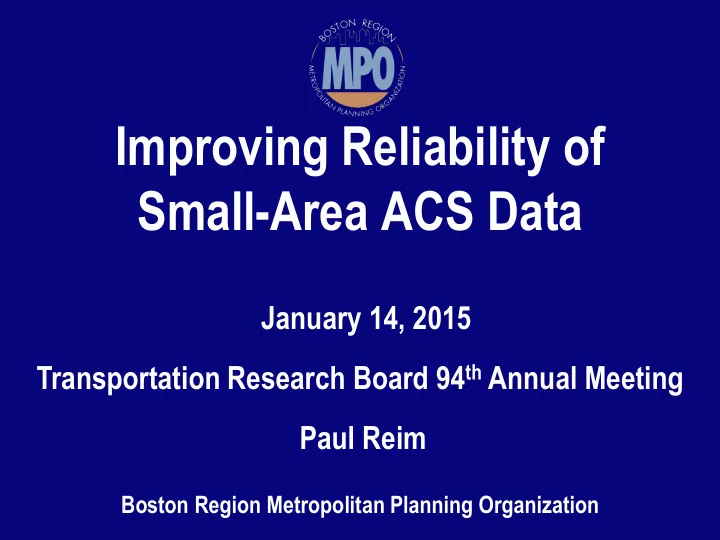

Improving Reliability of Small-Area ACS Data January 14, 2015 Transportation Research Board 94 th Annual Meeting Paul Reim Boston Region Metropolitan Planning Organization
Agenda 1. The need for, and problems with, small-area ACS data 2. A solution: the ‘touch method’ 3. Future trends
The Need for Small-Area Data • Equity analyses: Title VI, EJ • Corridor studies • Development reviews • Travel demand model inputs
MPO Model in 1990 Software: UTPS Modeled area: • 986 TAZs • 887 Census tracts • 3,623 Census block groups
MPO Model in 2002 Software: EMME/2 Modeled area: • 2,727 TAZs • 894 Census tracts • 3,324 Census block groups
MPO Model in 2014 Software: TransCAD Modeled area: • 2,727 TAZs • 976 Census tracts • 3,341 Census block groups
Statistical Testing and the ACS Two useful publications: • Multiyear Accuracy of the Data • Instructions for Applying Statistical Testing
Statistical Testing and the ACS Important statistics: • Margin of error (MOE): published with data • Standard error (SE) • Coefficient of variation (CV) • Z statistic
Example: HH by Income Quartile • Re-state the ACS estimates as proportions • Apply the proportions to 2010 Census counts • Allocate the resulting estimates to TAZ using factors derived from 2010 Census block statistics
Example: Using Block Group Data Percentage of table cells with CV <= 0.3: • 2000 Census SF3: 85% • 2006-2010 ACS: 41%
Example: Using Tract Data Percentage of table cells with CV <= 0.3: • 2000 Census SF3: 92% • 2006-2010 ACS: 87%
Solution: the Touch Method 2014 ACS Users Conference Presentations by: • Ken Hodges, Nielsen Company • Ben Horwitz: Greater New Orleans Community Data Center
Solution: the Touch Method Combine each block group’s estimates with those of its neighbors.
Example: Touch Method Percentage of table cells with CV <= 0.3: • 2010 ACS published: 41% • 2010 ACS touch method: 76%
Example: Compare Estimates • The touch method has produced block group estimates with better margins of error • The next step: evaluate whether the differences between estimates are statistically significant • How? The Z statistic
Example: Compare Estimates • Difference is statistically significant if Z is less than -1.645 or greater than +1.645 • We can use the touch method if the vast majority of its estimates do not differ significantly from published estimates • In this example, the difference is insignificant for 89% of cells in the table
Future Trends • ACS Sample size was increased beginning in 2011 • Improvements in margins of error and other statistics are already showing up
Example: 2012 ACS Block Group Percentage of table cells with CV <= 0.3: • 2006-2010 ACS published: 41% • 2008-2012 ACS published: 68%
Conclusions • Small-area 2010 ACS estimates have been shown to be less reliable than corresponding 2000 Census estimates • The touch method may provide more usable ACS estimates at the block group level • Increased sample size beginning in 2011 has had positive results
Recommend
More recommend